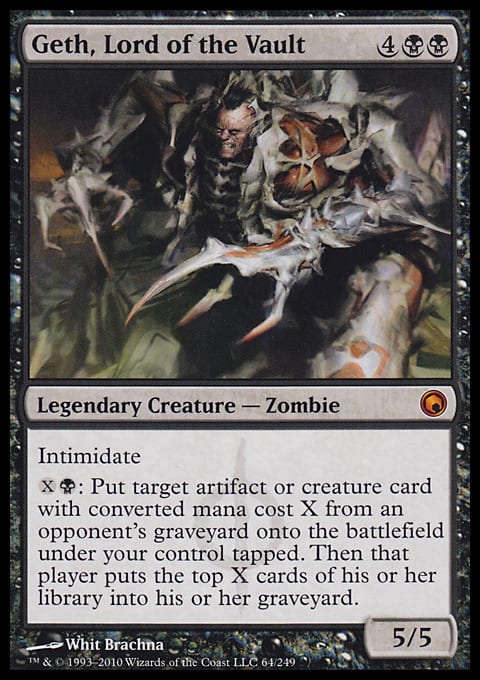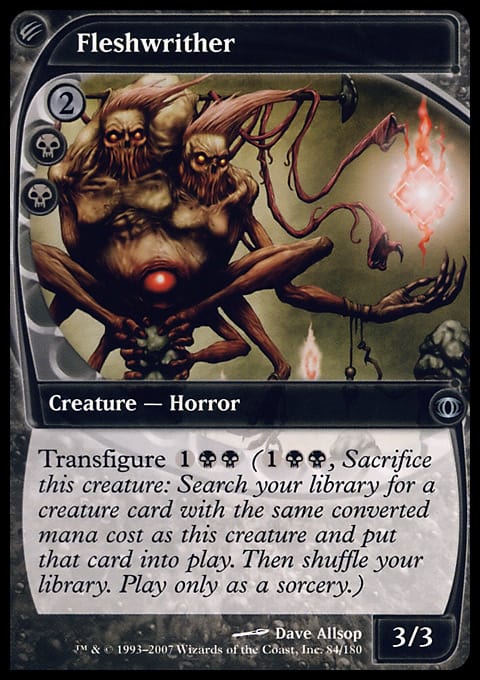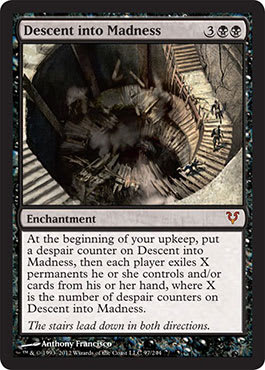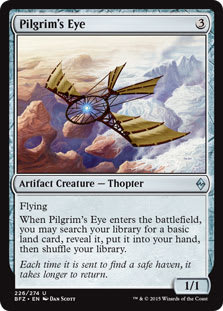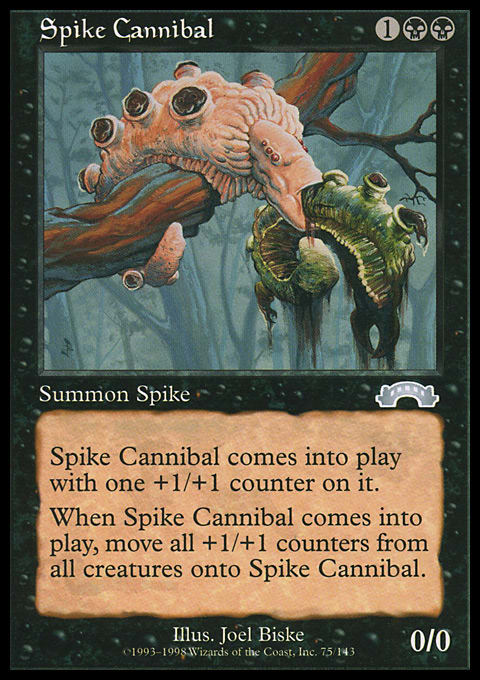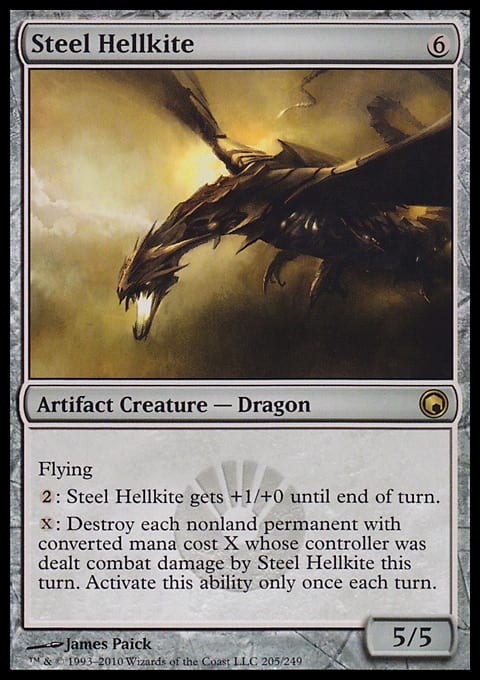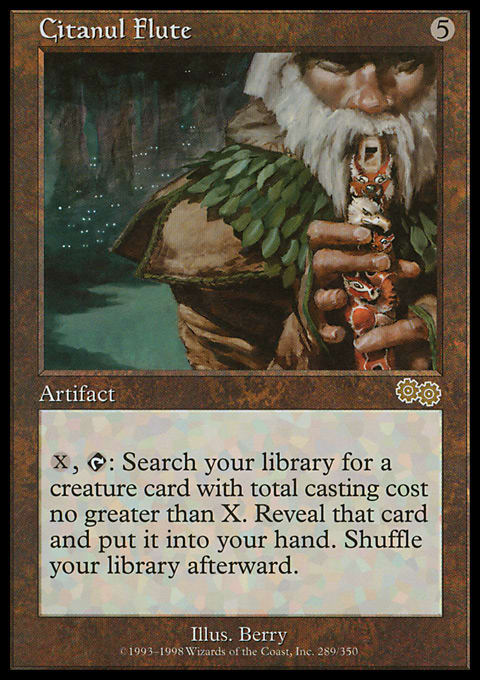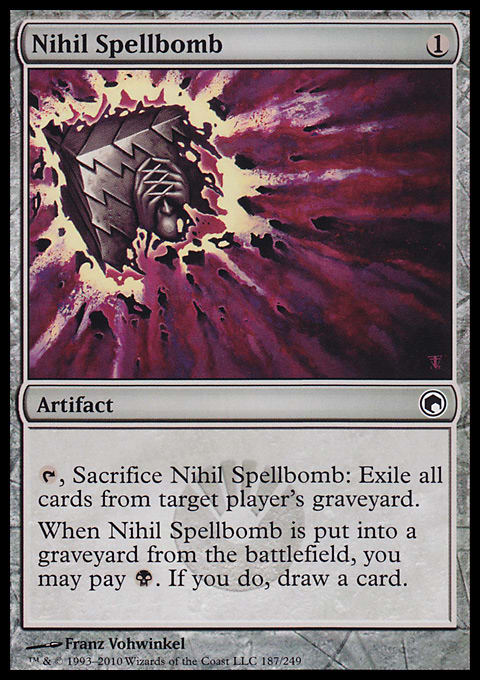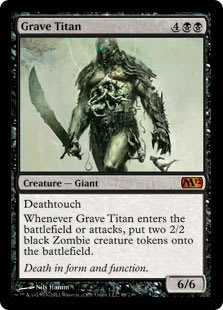One of the best ways to find inspiration for a Commander deck is to take an idea from the world of sixties and port it over. You can easily find yourself with surplus copies of one or two key cards, and there’s nothing better to do with those singletons than put them in a new Commander deck. Of course, the deck will run completely differently if your combo pieces are one in ninety-nine instead of four in sixty that’s a good thing because partly it increases variance, and partly because it’s a great deck-building challenge. Today, I’m going to look at the three-step process of porting over my ultra-powerful Zombie Stairwell deck into a Commander deck.
Here’s the original build in all its devastating glory:
"Stairway to Hell"
- Creatures (24)
- 1 Gravespawn Sovereign
- 2 Grave Titan
- 3 Gempalm Polluter
- 3 Khabal Ghoul
- 3 Withered Wretch
- 4 Twisted Abomination
- 4 Undead Gladiator
- 4 Korlash, Heir to Blackblade
- Spells (10)
- 3 Tendrils of Corruption
- 2 Drain Life
- 2 Call to the Grave
- 3 Oath of Ghouls
- Lands (26)
- 20 Swamp
- 2 Bojuka Bog
- 4 Tombstone Stairwell
The deck cycles its way into an early Tombstone Stairwell, overwhelms the table with ridiculous quantities of Zombies, brings back key critters it dumped into the graveyard with Oath of Ghouls and Cruel Revival, and then crushes any survivors with enormous frickin’ Zombies: any one of Khabal Ghoul (all ghouls are now Zombies, remember!), Korlash, Heir to Blackblade, and the inimitable Grave Titan can easily go all the way. Between the attacking hordes, the combination of spot removal, and Call to the Grave, this deck hits hard and fast and keeps up the pressure late in the game.
There are two particularly strong combos here amid the redundancy. First, if you have Oath of Ghouls and two copies of Korlash, you can use his grandeur ability to sustain the upkeep on Stairwell indefinitely, or as indefinitely as you need to kill everyone. Second, Gravespawn Sovereign can strip graveyards in preparation for a big Stairwell, and it becomes even better with the Stairwell in play and five critters in your ’yard. Every turn, you can tap your new tokens to steal the best creature in any graveyard.
Step 1 – Start at the Top
The first decision point when porting a sixty-card deck into the hundreds is to choose a commander. At first glance, it seems that Korlash is the obvious choice, on account of his being a powerful finisher who made it as a four-of in the original deck.1 However, what makes him truly indispensable is the grandeur ability, which obviously doesn’t work in a singleton format.
When porting over from sixties to hundreds, you have to consider more than just how well a critter works with your main plan—because it’s going to be a lot harder to make that plan come together. What you really want is something that plays nicely with the core plan (in this case, that’s Tombstone Stairwell with a nice, full graveyard) but also has plenty of power on its own and enhances the greater number of support cards that you’ll inevitably need to make it work. The obvious options here are Geth, Lord of the Vault and Mikaeus, the Unhallowed.
Geth suits a generic graveyard theme to a tee, being able to pillage your opponents’ graveyards and being one of the best mana sinks in the game. On the other hand, he may well create situations in which your opponents’ graveyards are so full that you can't profitably cast the Stairwell. In addition, a mana-intensive commander doesn’t play well with the cumulative upkeep on Stairwell. Since casting Stairwell is the name of the game, I’m reluctant to put Geth in charge—although if you’re a little more devil-may-care than I am, he’d still make a fine choice.
Mikaeus is my choice for three reasons. First, his Human-hating ways can make for a fine deterrent, which is not to be sneezed at. Second, his +1/+1 effect will make my creatures, especially an army of hasty Zombie tokens, far more effective. Third, the undying that he grants to my support creatures is going to make them all so much better, meaning that I won’t be reliant on a single win con.
On top of that, Mikaeus offers more options for out-Johnnying your opponents than Geth does, which is a big help for filling in those other ninety-nine card slots.
Step 2 – Synergy
The two core cards here are Tombstone Stairwell—the power behind the original deck—and Mikaeus—the most consistent part of the deck. When we talk about synergy for a deck like this, we’re going to focus on cards that work well with these two.
For Stairwell, the original deck was largely made up of cycling Zombies so that my graveyard and hand were both kept full and everything was set up for the Stairwell that I was digging my way toward. That was incredibly effective when eleven of the sixty cards were cycling creatures (counting Korlash, fully a quarter of the deck loves to throw itself into the graveyard). In hundred-card decks, though, I’m going to have to do it a little differently along three different axes:
- Loading up graveyards
- Emptying everyone else’s graveyard
- Take advantage of critter tokens coming and going
Unlike my Mimeoplasm deck, it isn’t enough to just load up everyone else’s graveyard indiscriminately, because if someone else has a higher creature density than you, you’re going to be swamped by creature tokens. Some of the cards that will shine with Tombstone Stairwell are . . .
Self-Service
I want creatures that will put themselves into my graveyard because that was such a key element of the original deck.- Undead Gladiator
- Viscera Dragger
- Stinkweed Imp
- Dimir House Guard
- Fleshwrither
- Gempalm Polluter
- Netherborn Phalanx
- Twisted Abomination
Asymmetry and Larceny
- Bojuka Bog
- Nihil Spellbomb
- Withered Wretch
- Nezumi Graverobber
- Bone Dancer
- Cemetery Reaper
- Eater of the Dead
- Geth, Lord of the Vault (with the aforementioned caveats)
- Gravespawn Sovereign
- Animate Dead
- Mimic Vat
- Ashen Powder
- Grimoire of the Dead
- Beacon of Unrest
- Rise from the Grave
I’ve Got a Lot of Creatures
- Shepherd of Rot
- Death Baron
- Phyrexian Ghoul
- Soulless One
- Undead Warchief
- Corpse Harvester
- Noxious Ghoul
- Xathrid Demon
- Butcher of Malakir
- Lord of the Pit
- Plunge into Darkness
- Attrition
- Urborg Justice
- Hecatomb
- Grave Pact
- Ritual of the Machine
- Descent into Madness
- Sword of the Ages
You’ve Got a Lot of (Dead) Creatures
- Blood Artist
- Blood Seeker
- Khabal Ghoul
- Falkenrath Noble
- Scavenger Drake
- Vengeful Dead
- Harvester of Souls
- Massacre Wurm2
- Patron of the Nezumi
- Koskun Falls
- Decree of Pain
- Overwhelming Forces
That’s a Mighty Big Graveyard
Dangerous territory; what I want is a way to put a lot of creatures in opponents’ graveyards or take advantage of that happening, but at the same time make sure they don’t have more than I do. After agonizing over it for weeks, I finally decided that the best way to go was to have a bunch of milling effects and rely on my high creature density to carry me through. If I run into something that can match me critter for critter (Lovisa tribal and Omnath ramp are two local decks that spring to mind), I’ll just try to take them out first.
- Apprentice Necromancer
- Extractor Demon
- Umbra Stalker
- Avatar of Woe
- Phyrexian Reclamation
- Tortured Existence
- Altar of Dementia
- Cellar Door
- Ghoul's Feast
- Mindcrank
- Oath of Ghouls
- Spoils of Evil
- Sands of Delirium
- Whetstone
- Twilight's Call
All of the above cards will work well in concert with Tombstone Stairwell, but most will still be effective without it. Turning now to cards that work well with Mikaeus, the Unhallowed, the first thing we notice is that Mikaeus already has great synergy with every non-Human creature in this list. Other cards that help to squeeze the most advantage out of Mikaeus are creatures with enters-the-battlefield abilities, cards that work well with +1/+1 counters on them, and cards that can take +1/+1 counters off our creatures.
Infinite Combo
My policy regarding easily attainable, sudden-death combos is simple: Piss off or I’ll beat you to death with your own severed limbs. As such, there will be no Triskelion in this deck. However, I am intrigued by Grim Poppet, both as a 7-mana Plague Wind, and also because it can save the team from a sweeper by removing +1/+1 counters. I’ll give it a try, but I will drop it at the first sign of back-breaking cheesiness.
Okay, maybe the second sign . . .
Value, Value, Value!
Is it surprising that I chose the commander who works best with ETB creatures? Probably not. It doesn’t matter, though; if Mikaeus didn’t demand a high creature count, Tombstone Stairwell does, so this deck is going to get as many effects from creatures as it can, starting with:- Pilgrim's Eye
- Bone Shredder
- Fleshbag Marauder
- Liliana's Specter
- Gravedigger (all variants, especially the ones that are already Zombies)
- Liliana's Shade
- Solemn Simulacrum
- Dark Hatchling
- Duplicant
- Rune-Scarred Demon
- Reiver Demon
Regrettably, perennial favorites Nekrataal and Big Game Hunter are Humans, so they don’t make the cut, but cards like this give me a little bit of everything.
Counter-Counter Tech
If you can keep Mikaeus alive, your opponents will have to kill your critters twice . . . or more. Here are a couple of tricks for getting more mileage out of Mikaeus’s undying love for his team:
- Spike Cannibal
- Dusk Urchins
- Harbinger of Night
- Ninjas!!
- Black Sun's Zenith
- Nim Deathmantle
- Erratic Portal
- Serrated Arrows
- Aether Snap
- Cauldron of Souls
- Conjurer's Closet
Ah, Spike Cannibal . . . I’ve had you for years and never found a home for you until now. Is there any better feeling for a Johnny?
Dusk Urchins is one I almost missed, but because it will almost never die with a +1/+1 counter on it, I can see it being a significant draw engine over the course of a game.
Serrated Arrows is a bit lame, I won’t lie, but it is at least worthy of consideration. There used to be a Rhys the Redeemed deck in my meta, and I think that the potential uses with Mikaeus and the ability to screw over a 1/1 commander repeatedly would make me put it in. As it stands, though, I’m unlikely to use it this time.
Conjurer's Closet is a fantastic card; if it still has junk-rare status at your local game store, I urge you to pick up a couple of sets. It just makes every creature a little bit spicier!
Thinking Big
Mikaeus means that all our creatures have undying, which means that we can sacrifice stuff for value without erasing our board position. My first thought was Forbidden Ritual and a ton of Tombspawn tokens, but the Ritual is apparently limited to nontoken permanents. On the other hand, we will have a lot of lands in play, and old-school Johnny card Kormus Bell can allow us to benefit from the Ritual in a big, big way. Even half a dozen creatures can make the Ritual a real beating if you have Mikaeus out, but throw in ten or more lands (and of course the actual Kormus Bell—you don’t want your now-3/3 Swamps all going to the bin a second time) and Forbidden Ritual will absolutely castrate the biggest threat at the table at virtually no cost to you.
Step 3 – Expand the Core
Here, you’re looking at ways to fill the deck out; critters and basic functions such as removal, acceleration, and so on. These cards need to work well with the two core elements of Stairwell and Mikaeus but also smooth your curve and provide depth. Shockingly, this is going to result in a deck that looks even more like a Zombie tribal build; you could force the deck in other directions, but I think the natural synergies of the deck lie in tribal, and lucky for us, we just got through the most Zombie-lovin’ block in the history of ever, so we have a lot of great options.
Dawn of the Dead . . . Again
- Sarcomancy
- Rotting Rats
- Adaptive Automaton
- Unbreathing Horde
- Grave Defiler
- Graveborn Muse
- Unliving Psychopath
- Helldozer
- Nefashu
- Living End
- Endless Ranks of the Dead
- Moan of the Unhallowed
- Cruel Revival
- Dawn of the Dead
- Living Death
- Zombie Apocalypse
- Army of the Damned
Because We’re Playing Black
Green can kill creatures these days, and blue has fairly efficient answers to anything, but black still can't do squat against enchantments and artifacts, so as long as you’re running mono-black, you need to consider at least some of the following:- Ratchet Bomb
- Oblivion Stone
- Nevinyrral's Disk
- Steel Hellkite
- Nightmare Incursion
- Karn Liberated
- Spine of Ish Sah
- Phyrexia's Core
Ratchet Bomb is worth having as a specific answer—especially as a deterrent against a powerful commander—and even Ratchet Bomb for 0 acts as insurance against out-of-control Zombie tokens. The others may be staples/crutches, but as long as black gets the shaft in the color pie (along with red), we need to fall back on these kinds of colorless answers.
Assembling the Doomsday Engine
Apparently, tutors are useful. I already have a bunch of tutoring creatures, but let’s have some spells.- Vampiric Tutor
- Demonic Tutor
- Praetor's Grasp
- Diabolic Tutor
- Brainspoil
- Citanul Flute
- Increasing Ambition
Murder
All of the usual suspects here—Terrors, Edicts, and Sweepers. Fortunately, Barter in Blood was reprinted, so it’ll be easy to find extra copies for this deck. Here’s hoping Innocent Blood comes out in Magic 2013 because I’m using all my copies at the moment.
Pro-Life
There’s a possibility that I could be playing Shepherd of Rot, Graveborn Muse, and Tombstone Stairwell in the same deck, so yes, I will put in a bunch of Drain effects. Also, if all goes well, I’ll be able to whittle down everyone’s life total equally with Zombie beats, so Exsanguinate may be able to finish the whole table.
Putting it all Together
Building a deck means thinking of more cards than you need, and so far, I have over a hundred nonland cards. Here’s how my first take on the final ninety-nine looks:
"The Real Zombie Horde"
- Commander (0)
- Creatures (34)
- 1 Blood Artist
- 1 Bone Shredder
- 1 Butcher of Malakir
- 1 Cemetery Reaper
- 1 Corpse Harvester
- 1 Dark Hatchling
- 1 Dimir House Guard
- 1 Dusk Urchins
- 1 Eater of the Dead
- 1 Falkenrath Noble
- 1 Gempalm Polluter
- 1 Gravespawn Sovereign
- 1 Khabal Ghoul
- 1 Massacre Wurm
- 1 Netherborn Phalanx
- 1 Nezumi Graverobber
- 1 Noxious Ghoul
- 1 Rune-Scarred Demon
- 1 Shepherd of Rot
- 1 Skullsnatcher
- 1 Spike Cannibal
- 1 Twisted Abomination
- 1 Unbreathing Horde
- 1 Undead Gladiator
- 1 Undead Warchief
- 1 Vengeful Dead
- 1 Viscera Dragger
- 1 Withered Wretch
- 1 Pilgrim's Eye
- 1 Solemn Simulacrum
- 1 Geth, Lord of the Vault
- 1 Ink-Eyes, Servant of Oni
- 1 Korlash, Heir to Blackblade
- 1 Patron of the Nezumi
- Spells (27)
- 1 Cruel Revival
- 1 Plunge into Darkness
- 1 Tendrils of Corruption
- 1 Terror
- 1 Army of the Damned
- 1 Corrupt
- 1 Demonic Collusion
- 1 Exsanguinate
- 1 Living Death
- 1 Overwhelming Forces
- 1 Rise from the Grave
- 1 Zombie Apocalypse
- 1 Call to the Grave
- 1 Endless Ranks of the Dead
- 1 Grave Pact
- 1 Hecatomb
- 1 Infernal Tribute
- 1 Oath of Ghouls
- 1 Tombstone Stairwell
- 1 Altar of Dementia
- 1 Journeyer's Kite
- 1 Mimic Vat
- 1 Mindcrank
- 1 Nevinyrral's Disk
- 1 Nihil Spellbomb
- 1 Spine of Ish Sah
- 1 Tsabo's Web
- Lands (38)
- 38 Lands
Wow, talk about a tough set of decisions! To help with the winnowing process, I put all of the cards I could actually find into a spreadsheet, splitting it up between creatures and spells along the verticals and mana costs (0–2, 3–4, 5–6 and 7+, including X spells) on the horizontal. As usual for a tribal build, the mana curve for creatures doesn’t yield much diversity; in this case, Zombies have typically been costed at 3 or 4 since Alpha. I ended up with twenty-eight creatures that I wanted (neeeeded!) in the 3–4 slots, most of which were Zombies. Making those cuts was hellaciously tough, as were most of the decisions for the rest of the slots.
Here’s what I ended up with that made me very happy with the build:
35 Creatures – Having a lots of critters, especially cheap ones, lets me set the pace of the game early, get the most out of Mikaeus, and have a nice, full graveyard in the mid- to late-game for when Tombstone Stairwell hits.
6 Blood Artist effects – In multiplayer, creatures will die—usually because I kill them, but sometimes for other reasons—and Tombstone Stairwell drives this into overdrive. One of the interactions I wanted to maximize with this build was to bleed my opponents every time this happens, and I think I did pretty well here, with Blood Artist, Vengeful Dead, Falkenrath Noble, Vengeful Dead, Patron of the Nezumi, and the mighty, mighty Massacre Wurm all bleeding my opponents when their critters die. Tombstone Stairwell plus Vengeful Dead or any of these others equals a swift and sudden death for your opponents.
On top of that, when Netherborn Phalanx hits the table, it punishes your opponents for having creatures out—hit ’em coming and going! This suite is so powerful that I didn’t even notice the lack of a Blood Seeker, although I’ll definitely look for a way to put it in, perhaps even in place of my thirty-eighth land.
5 Graveyard-removal effects – Obviously, again, these are most important for the Stairwell, but with so much recursion in Commander, having access to Nihil Spellbomb, Withered Wretch, Nezumi Graverobber, Cemetery Reaper, and Eater of the Dead means that I’m going to be able to incidentally hump over recursion-based decks while also beating down and furthering my own game plan.
Massive cycling power – I have so many ways to draw extra cards in this deck that I feel comfortable running a mere thirty-eight lands in a deck with no artifact acceleration and a 6-drop commander. Churning through my deck gives me something much closer to a ninety- to ninety-five-card deck, for which thirty-eight lands is plenty.
Out-of-the-box card choices – Even your favorite cards can become boring for both you and your opponents if you play them in every deck. That’s why, as a deck builder and a fan of the game, I like to play with cards that people don’t expect from time to time. Sure, I’m running Sad Robot, Geth, Massacre Wurm, and other popular/over-played cards,3 but I’m also running Infernal Tribute, Plunge into Darkness, Hecatomb, Eater of the Dead, and Skullsnatcher; if you’ve seen all of those in play before, I envy you your metagame!
Appetite for Brains – Even without the Stairwell and Mikaeus, this deck is dripping with Zombie goodness. Or badness. Either way, this deck captures the feel of creeping, undead inevitability like few others, which makes it a home run flavor-wise without sacrificing too much power. I couldn't find room for Grave Titan, but with this much Zombie power, he’s barely missed.
Redundancy – Taking all of those positives together, this is a deck with a great deal of redundancy and consistency and a surprising amount of depth without being boring or predictable.
However – All of those successes come at a cost. Next week, I’m going to talk about the downside of all those strengths and look at how we can address the bad feeling that a deck like this might leave in some deck builders’ mouths. Spoiler alert: I’m not just talking about the taste of rotting flesh!
1 I know this is pretty subjective, but I honestly think that Korlash might just be the best standalone commander in mono-black. The only reason I don’t already have him as a commander for one of my many mono-black decks is that my only copies have been anchoring the Stairwell deck.
2 Because Wurms can climb stairs.
3 Although this will be my first time running Massacre Wurm; I underestimated how popular and therefore expensive it would be, and I only recently picked up my first one in a trade.













